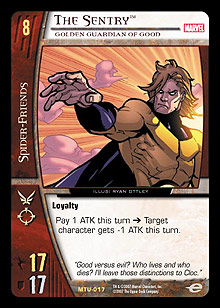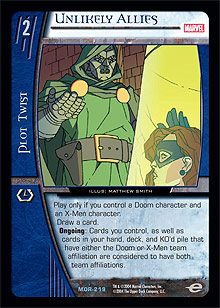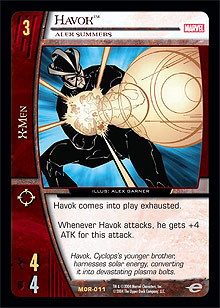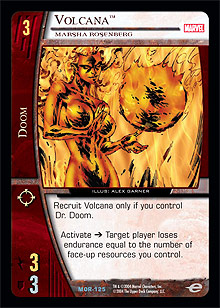
|
The Sentry™
Card# MTU-017


While his stats aren’t much bigger than those of the average 7-drop, Sentry’s “Pay ATK” power can drastically hinder an opponent’s attacking options in the late game.
Click here for more
|
|
|

|
|
|

 |
 |
|
|
| |
|
Virtually everything has a cost. Whether it's in life or in a card game, very rarely is anything truly free. "Free" is a term thrown around in relation to TCGs a lot—something is "free to play" if it doesn't have a discard cost, threshold cost, or cost from a finite pool of resources (like a recruit cost). In reality, we all understand that virtually all cards in any TCG come with costs inherent to game structure. In order to use a card, you need to include it in your deck, which means possibly foregoing other choices. You're also giving up hand advantage in the case of using most cards (drawing cards like Yu-Gi-Oh!'s Pot of Greed, or cards that replace themselves in the hand, such as Gather Your Mind, being obvious exceptions). But since these are basically given factors for any card in any TCG, they're discounted when considering whether or not a card is "costed" by players in most cases.
Writing an article series comes with a cost, too. The series has a finite length, and when the end is reached, its writer needs to come up with fresh ideas. With this, the sixth instalment of "Adjusting to Vs.," I reach that point. After this, you'll see me doing a regular weekly column here on Metagame.com, but for today, we're going to examine the ways in which cards are costed thus far in the Vs. System's first release, Marvel Origins.
 The first and most obvious form of costing are the basic costs—recruit cost and threshold cost. This is the first level of distinction between a low power and high power card. It's obvious and very straightforward—low-power cards get low costs, high-power cards get higher costs. The first and most obvious form of costing are the basic costs—recruit cost and threshold cost. This is the first level of distinction between a low power and high power card. It's obvious and very straightforward—low-power cards get low costs, high-power cards get higher costs.
Almost as obvious in the costing of characters are stats, ATK and DEF. A character with high stats for its placement on the cost curve, like Thing: Heavy Hitter or Wolverine: Logan will have high stats but will generally have a drawback as an additional cost. In contrast, if a card has a particularly great effect, it will probably have at best average stats. Mr. Fantastic: Scientific Genius and Invisible Woman: Sue Richards both immediately come to mind as cards that have the lowest stats possible for their segment on the curve, but that have exceedingly beneficial effects (capturing, of course, the flavour of the FF comic books, in which the team tends to use planning and cleverness to make up for their lack of brute force). Odds are good that if a card is very low in ATK and DEF, one of the two following statements is true:
a) The card just happens to be bad.
b) The card has an effect that makes working around its low stats worthwhile and potentially in the best interest of players.
These two methods of costing—literal cost under the core mechanics of the game, and printed statistics compensating for an effect—are staples of any good TCG. If you're reading this article, you've probably seen them before, and you're probably waiting for me to get the specifics. Well, luckily for you, Marvel Origins has about twelve additional consistent trends in costing that go beyond those already addressed, and here we find the interesting meat of this discourse.
 Required board presence of other cards is one of the first specific systems of costing a player might see in the game. Looking through spoilers for the first time, or cracking your first few packs, the mechanic of "cards that need other cards to be in play before they can be played" emerges. Magneto: Master of Magnetism, Thing: Heavy Hitter, and Professor X: World's Most Powerful Telepath are all examples of cards that have the line "Recruit [this card] only if you control another [team affiliation] character" as part of their effect text. The result is that a player has to consider and choose at least one of several different ways to meet the team-affiliation requirement of these cards if he or she wishes to play them. Obviously, one could take the obvious way out, running Magneto in an all-Brotherhood deck, Thing in an all-Fantastic Four deck, and Professor X in an all-X-Men deck. But really, that's only one answer to costing of this type. You can run Doomstadt to use cards that require you to control Dr. Doom. You can use Mutant Nation and a splash of Brotherhood to make your X-Men count as Brotherhood, and thus recruit Magneto: Master of Magnetism requirement long after your splashed Brotherhood character bites the dust. You can do the same in reverse to use Professor X: World's Most Powerful Telepath in a Brotherhood deck. The possible end product? X-Men swarm decks that can use War on Humanity, The Mutant Menace, and Mutant Supremacy to deal out amounts of early-game and mid-game pressure that would be impossible otherwise, and that can use Magneto: Master of Magnetism in the late game where the deck would normally have to call it quits. So a required board presence of another card for recruitment of a character is one form of costing, but it can be dealt with in several different ways which each present their own costs as well. Required board presence of other cards is one of the first specific systems of costing a player might see in the game. Looking through spoilers for the first time, or cracking your first few packs, the mechanic of "cards that need other cards to be in play before they can be played" emerges. Magneto: Master of Magnetism, Thing: Heavy Hitter, and Professor X: World's Most Powerful Telepath are all examples of cards that have the line "Recruit [this card] only if you control another [team affiliation] character" as part of their effect text. The result is that a player has to consider and choose at least one of several different ways to meet the team-affiliation requirement of these cards if he or she wishes to play them. Obviously, one could take the obvious way out, running Magneto in an all-Brotherhood deck, Thing in an all-Fantastic Four deck, and Professor X in an all-X-Men deck. But really, that's only one answer to costing of this type. You can run Doomstadt to use cards that require you to control Dr. Doom. You can use Mutant Nation and a splash of Brotherhood to make your X-Men count as Brotherhood, and thus recruit Magneto: Master of Magnetism requirement long after your splashed Brotherhood character bites the dust. You can do the same in reverse to use Professor X: World's Most Powerful Telepath in a Brotherhood deck. The possible end product? X-Men swarm decks that can use War on Humanity, The Mutant Menace, and Mutant Supremacy to deal out amounts of early-game and mid-game pressure that would be impossible otherwise, and that can use Magneto: Master of Magnetism in the late game where the deck would normally have to call it quits. So a required board presence of another card for recruitment of a character is one form of costing, but it can be dealt with in several different ways which each present their own costs as well.
 Many cards are also pseudo-costed in similar ways. Cards like Professor X: Charles Xavier and Robot Enforcer are passable on their own but need a maintained source of field presence establishing a team affiliation to use their full effects. Again, you could just run Charles in an X-Men deck and Robot Enforcer in a Doom deck, but you could also address the pseudo-cost with the plot twist Unlikely Allies, running Charles and Robot Enforcer with other X-Men like Psylocke: Betsy Braddock to give more hand control, and cheap Doom-affiliation characters to provide reinforcement and damage on team attacks. The result would be an X-Men hand control deck with the added oomph of hand disruption in the form of the Enforcer. The Enforcers and other Doom characters could also have all the benefits of X-Men specific cards, like Children of the Atom and Fastball Special. Many cards are also pseudo-costed in similar ways. Cards like Professor X: Charles Xavier and Robot Enforcer are passable on their own but need a maintained source of field presence establishing a team affiliation to use their full effects. Again, you could just run Charles in an X-Men deck and Robot Enforcer in a Doom deck, but you could also address the pseudo-cost with the plot twist Unlikely Allies, running Charles and Robot Enforcer with other X-Men like Psylocke: Betsy Braddock to give more hand control, and cheap Doom-affiliation characters to provide reinforcement and damage on team attacks. The result would be an X-Men hand control deck with the added oomph of hand disruption in the form of the Enforcer. The Enforcers and other Doom characters could also have all the benefits of X-Men specific cards, like Children of the Atom and Fastball Special.
Another form of costing to recruit or activate a card is the discard of cards in the hand, either determined by the player, or specific. For instance, Children of the Atom requires an X-Men card to be discarded from your hand in order to be activated, while Sabretooth: Feral Rage requires the discard of a Brotherhood character from your hand to be recruited. Negative Zone requires a discard of any card of your choice from your hand to be flipped. This cost is also used for pseudo-costing. For instance, Super Skrull: Engineered Super-Soldier is an alright six-drop with 10 ATK and 10 DEF—not shabby, but not great. However, if you discard a card from your hand when he attacks, you get a whopping series of extra effects: +3 ATK/+3 DEF, readying of all front-row Skrulls you control, and direct endurance loss in the amount of 3 points to each opponent—very cool.
Moving back to an obvious cost, activation is one of the most basic costs in the set. It requires an exhaustion, and thus in most cases, you relegate the character that you are activating to the sidelines for any offensive maneuvers you might want to engage in for this turn. You also commit to the one-time usage of their effects then and there at the time of activation, barring intervention via a card like Cosmic Radiation later in the turn.
 Of course, to take the idea of exhaustion for a turn as an option and extend it to an extreme, some cards are costed by the fact that they're virtually useless the turn they come into play. For instance, Havok: Alex Summers has decent stats for his place on the curve, but gains a +4 ATK when he makes an attack. This is a great effect, and would be potentially broken, save for the fact that he comes into play exhausted. This delay evens out the playing field quite a bit, and makes a player think twice about managing initiative in a deck fielding Havok. Of course, to take the idea of exhaustion for a turn as an option and extend it to an extreme, some cards are costed by the fact that they're virtually useless the turn they come into play. For instance, Havok: Alex Summers has decent stats for his place on the curve, but gains a +4 ATK when he makes an attack. This is a great effect, and would be potentially broken, save for the fact that he comes into play exhausted. This delay evens out the playing field quite a bit, and makes a player think twice about managing initiative in a deck fielding Havok.
Lastly along this line, some cards impose more precise restrictions than exhaustion. Cards like Cosmic Radiation prevent an exact action, in this case attacking, as part of the cost of using them. Such cards require a strategic commitment both in deck building and in play style, and because they are so specifically constructed, they're often evidence of alot of careful playtesting of a card. Similarly, certain cards have restrictions on when they can be used. For instance, Professor X: Charles Xavier's effect is so powerful that it has to be limited to the combat phase, so as to not be useable during the build phase when it could effectively lock down an opponent entirely. I'd personally watch for this cost to see an influx in future releases as the game becomes more and more complicated.
 In addition to discarding from the hand, the resource row can also be used as payment for costed cards. Foiled, Ka-Boom!, Underground Sentinel Base, and The Power Cosmic all require at least one of the cards in your resource row to be removed to another zone of play. In the case of Foiled and Ka-Boom!, the cards knock themselves out. The Power Cosmic is a bit more dramatic, in that it knocks out every card in your resource row. Underground Sentinel Base plucks a Sentinel character from your resource row and puts it into play. Other cards remove cards from the resource row, only to immediately replace them, such as Relocation, and Jean Grey: Marvel Girl. It's worth it to note that Avalanche: Dominic Petros doesn't fit into this category because though he replaces a resource, his effect is an offense-centric one, and he does the replacing on the opponent's side of the field. Keeping up with the curve is hugely important in the Vs. System, so any card that requires you to remove cards from the resource row, regardless of where they go once removed, is likely going to have a very noteworthy effect. In addition to discarding from the hand, the resource row can also be used as payment for costed cards. Foiled, Ka-Boom!, Underground Sentinel Base, and The Power Cosmic all require at least one of the cards in your resource row to be removed to another zone of play. In the case of Foiled and Ka-Boom!, the cards knock themselves out. The Power Cosmic is a bit more dramatic, in that it knocks out every card in your resource row. Underground Sentinel Base plucks a Sentinel character from your resource row and puts it into play. Other cards remove cards from the resource row, only to immediately replace them, such as Relocation, and Jean Grey: Marvel Girl. It's worth it to note that Avalanche: Dominic Petros doesn't fit into this category because though he replaces a resource, his effect is an offense-centric one, and he does the replacing on the opponent's side of the field. Keeping up with the curve is hugely important in the Vs. System, so any card that requires you to remove cards from the resource row, regardless of where they go once removed, is likely going to have a very noteworthy effect.
Getting back to some of the more unorthodox costing systems, the KOd pile itself is explored briefly as a source of a numerical threshold in Marvel Origins. Both Colossus: Peter Rasputin and Jean Grey: Phoenix Force have effect text that utilizes this interesting idea. Colossus is only pseudo-costed—he's ok for a six-drop, but gains +5 ATK when there are five or more X-Men characters in your KO'd pile. Jean Grey: Phoenix Force is costed fully, not being recruitable until at least one Jean Grey has already bitten the dust. While Colossus: Peter Rasputin shares his status as a character pseudo-costed by the KO'd pile threshold with Spiral: Ricochet Rita, Jean Grey: Phoenix Force bears the interesting distinction as the only character that currently has a KO'd pile requirement to be recruited. I'm sure with how often characters come back from the dead in comic books, this is a costing mechanic we're probably going to see more of in the future.
Lastly, there are a few minor costing effects that are very interesting and could see use in later sets. I've talked about discarding cards from the hand, but the lighter version of that same theme, sacrificing hand count, is giving away information about your hand to the opponent. Wolverine: Logan is at the height of its level on the curve, with a 6 ATK/6 DEF for a mere 3 points, however, in order to recruit him you must reveal an X-Men character from your hand. The cost is two-fold. Not only are you giving away what might be next for your opponent, you're also required to have the specific team affiliation in hand, which means you're probably going to need to be packing a decent number of X-Men to play Logan.
 Position of resources is also a form of costing, as represented by Hulk: New Fantastic Four and Volcana: Marsha Rosenberg. So far we've only had a taste of this mechanic—Hulk and Volcana are only pseudo-costed. But think of the possibilities: decks that require restraint in the resource row to work or offer acceleration benefits to those who exercise that restraint (as seen with The New Brotherhood). Or alternatively, decks that reward aggression in the resource row and focus on never missing a valid resource row drop of a plot twist or location, so that all of them can be face up as often as possible, and thus activate specialized effects or allow for the recruiting of specialized characters. Very cool possibilities with alot of interesting promise. Position of resources is also a form of costing, as represented by Hulk: New Fantastic Four and Volcana: Marsha Rosenberg. So far we've only had a taste of this mechanic—Hulk and Volcana are only pseudo-costed. But think of the possibilities: decks that require restraint in the resource row to work or offer acceleration benefits to those who exercise that restraint (as seen with The New Brotherhood). Or alternatively, decks that reward aggression in the resource row and focus on never missing a valid resource row drop of a plot twist or location, so that all of them can be face up as often as possible, and thus activate specialized effects or allow for the recruiting of specialized characters. Very cool possibilities with alot of interesting promise.
Lastly, some cards require a player to take an endurance loss to activate their effect. There are no purely-costed characters yet that require an endurance loss to be recruited (Random Punks can maybe be seen in this light) but there are many effects in Marvel Origins that require payment in the form of endurance. Iceman, Nightcrawler: Fuzzy Elf, Storm: Ororo Munroe, the Super Nova and Johnny Storm versions of Human Torch, Invisible Woman: Sue Richards, Mr. Sinister, Mr. Fantastic: Stretch, and Sabretooth: Victor Creed all have effects that are at the least interesting, and are sometimes flat out superb, which require an endurance loss as part of their activation. Political Pressure and Salvage can be reused each turn if you pay an endurance cost. As an interesting counter-balance to these costs, Ghost Rider: New Fantastic Four gets an ATK bonus when his controller is at or below twenty-five endurance, an interesting way to use the endurance total as a costing threshold, instead of a finite pool (much like how the resource row generates both recruit points for characters and equipment, as well as threshold for plot twists and locations).
So, now you've seen the rundown of the various costs in Marvel Origins. What's next? Well, I'm not on the design team, so I don't know. However, I'd imagine we can look forward to lots of new costs, groupable into three different categories of thought.
First, reversed costs. We've seen discarding cards, and paying life points, but how about giving the opponent cards, or giving the opponent life points? A lot of the systems of costing in Marvel Origins are easily reversed, and I wouldn't be surprised if we see costing systems that are polar opposites of what we've seen before.
 Next, further exploration of established costs. So Hulk likes his resource row face down, and Volcana likes it face up. Ghost Rider likes it when you're half-dead. I could see alot of future costs being seen as "new" by most players, actually being explorations of minor cost systems that have only begun to be explored in Origins. How would you play against a deck that is full of Ghost Rider-esque cards? One that took a big of a pounding in the early game, but then ripped you apart to claim its revenge after it hit that magic 25 endurance total? How would you build a deck that ideally intended never to flip over its resource row, thus gaining ATK and DEF bonuses, special effects, and access to characters that could only be recruited if you didn't have any face up locations or plot twists? I really think there are some cool mechanics that have only been touched upon in Marvel Origins, and I wouldn't be surprised to see them make a return in future releases. Next, further exploration of established costs. So Hulk likes his resource row face down, and Volcana likes it face up. Ghost Rider likes it when you're half-dead. I could see alot of future costs being seen as "new" by most players, actually being explorations of minor cost systems that have only begun to be explored in Origins. How would you play against a deck that is full of Ghost Rider-esque cards? One that took a big of a pounding in the early game, but then ripped you apart to claim its revenge after it hit that magic 25 endurance total? How would you build a deck that ideally intended never to flip over its resource row, thus gaining ATK and DEF bonuses, special effects, and access to characters that could only be recruited if you didn't have any face up locations or plot twists? I really think there are some cool mechanics that have only been touched upon in Marvel Origins, and I wouldn't be surprised to see them make a return in future releases.
Finally, stuff totally out of left field. The Vs. team has come up with some really crazy stuff. The Power Cosmic, KO'ing all your resources for one huge push when it's not expected? The Brotherhood frantically trying not to develop their curve to take advantage of The New Brotherhood? Those are weird, powerful cards that really stretch the limits of the Vs. System, and I don't think the team will start there. We have Dual Sidearms—what about 0 recruit-cost characters? How about plot twists that give you the option to play them normally or as ongoing, and that do different things depending on which decision you make? And who's to say that threshold costs will always be for plot twists and locations, and that recruit costs will only ever be printed on characters and equipment? These ideas might be a bit extreme, but I'm sure future sets are going to press the limits of the Vs. System, as well as surprise players.
So now you know pretty well about the costs that are, and you probably have gears turning as to what might be. If you've read the full series, and you've been playing, you're probably quite good at the game by now, and if you're like me, you're drooling with anticipation to see what comes out next. You're ready to go, you're armed with experience and knowledge, and for lack of a better cliché, it's clobberin' time!
Thanks for reading! Any questions or comments can be sent to Jason@metagame.com.
|
| |
| Top of Page |
|
 |
|
|
 |